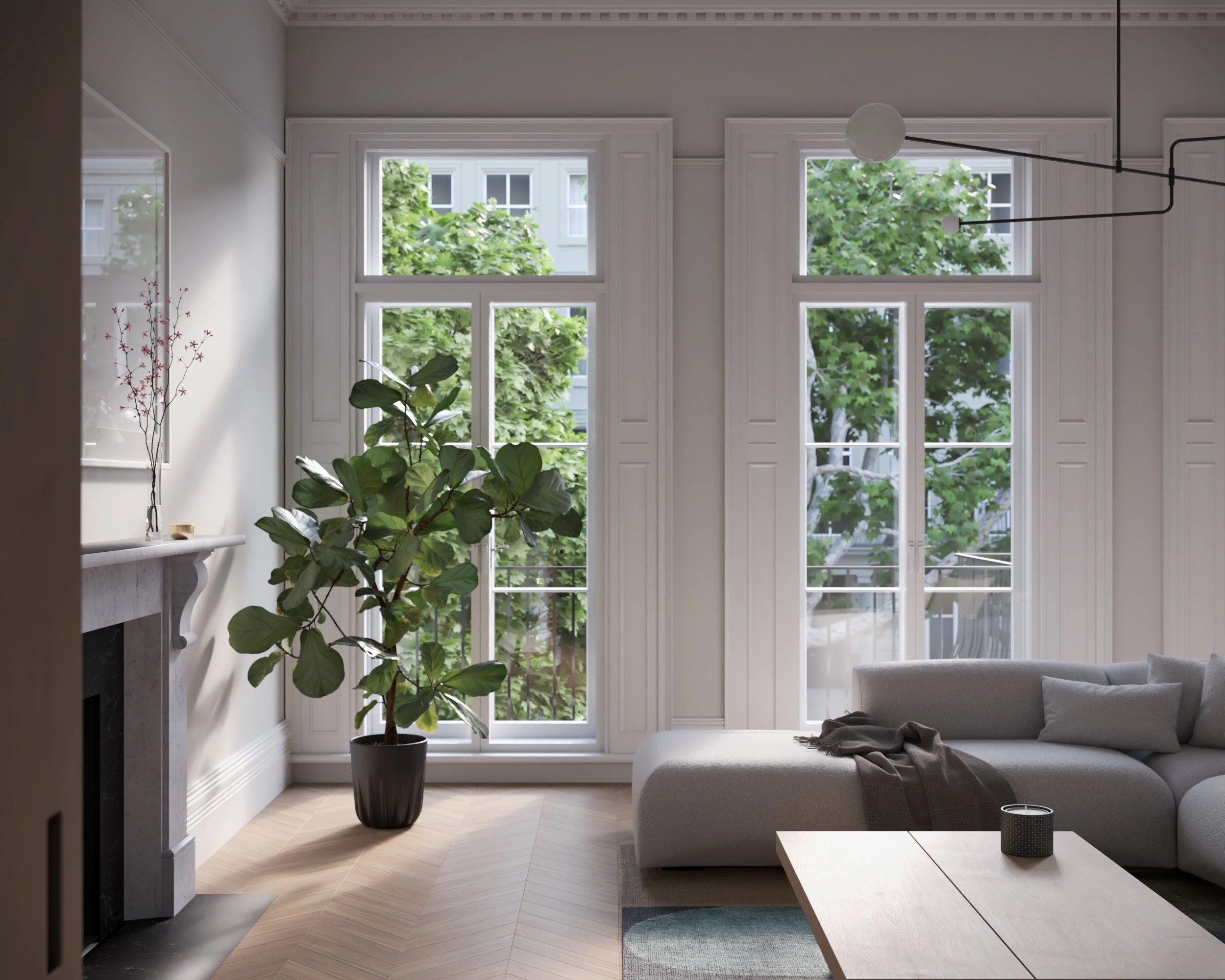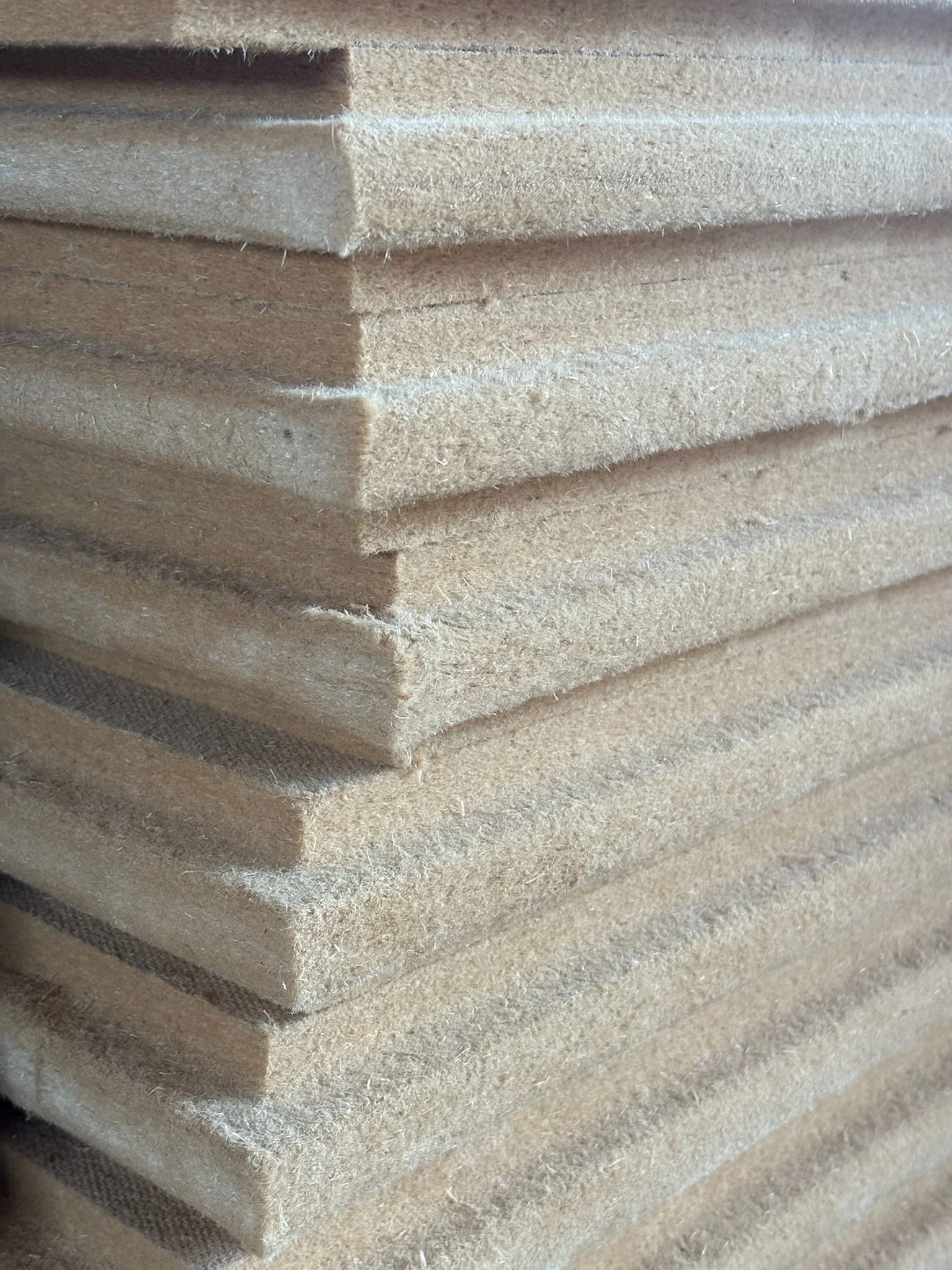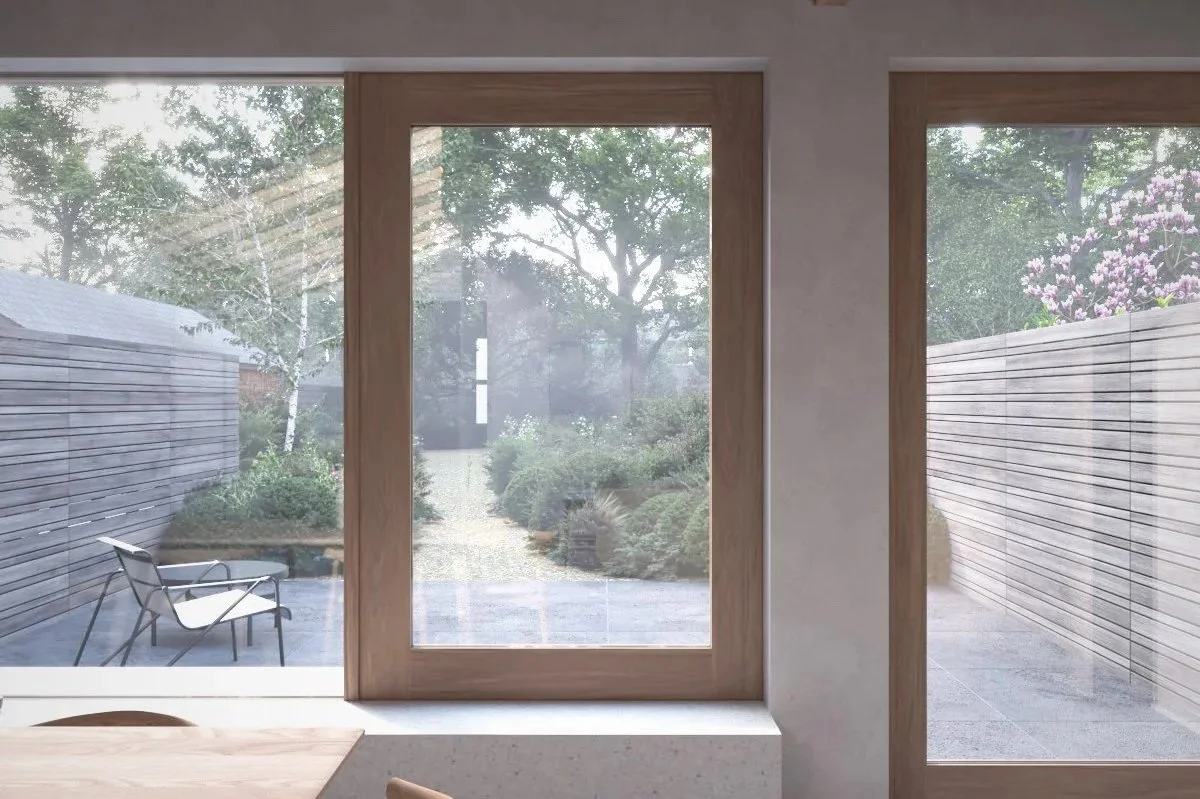Journal: Ideas & Insights for Sustainable Homes and Retrofits
Our Journal shares expert guidance, creative inspiration, and practical advice from eco-friendly, sustainable architects in London. Whether you’re planning a low-energy extension, a sensitive retrofit of a period property, or a future-ready new build, you’ll find insights here on Passivhaus principles, natural materials, and planning advice to help you create a brighter, warmer, healthier home that works beautifully today and tomorrow.
Internal vs External Wall Insulation for London Period Homes
If you are unsure whether internal or external wall insulation is right for your Victorian or Edwardian home, this guide will help you understand the benefits, challenges and planning considerations of each approach. You will find clear explanations written for London homeowners, with a focus on comfort, moisture safety and long-term performance.
Avoiding Damp and Mould in London Retrofits: A Homeowner Guide
Damp and mould often appear slowly in London period homes. Corners cool down, condensation gathers and a faint musty smell begins to show. This guide explains how insulation, ventilation and breathable materials work together to keep moisture moving in the right direction. A simple path to a home that feels brighter, warmer and easier to live in.
Airtightness and Ventilation for Old London Houses in Plain English
A simple guide to airtightness and ventilation for London period homes. Learn how to keep your retrofit warm, dry and comfortable with the right approach.
Insulating a Victorian terrace in London: a practical guide
A Victorian terrace can be a wonderful home, but many lose heat quickly and suffer from cold rooms, condensation and rising energy costs. This practical guide explains how to insulate a Victorian terrace in London in a way that protects the original brick, manages moisture and creates a warmer, healthier home. You will learn where heat is lost, which materials work best and how to plan the upgrades in a sensible order.
Insulation Scandal? Why Good Design and Oversight Matter More Than Ever in Retrofit
A government-backed insulation scheme meant to cut bills and carbon has left thousands of homes colder, damper, and in some cases uninhabitable. At the heart of the scandal is not insulation itself, but poor design, bad workmanship, and missing oversight. This blog explores why breathable materials, moisture-aware detailing and proper ventilation matter — and what homeowners can do to avoid the same mistakes.
The Three Models Every Design Needs for a Successful Outcome
Every successful home design balances three things: how it feels, how it performs, and how much it costs. At Studio CMA, we use three essential models — 3D design, energy modelling, and cost forecasting — to test ideas before they’re built. The result? Smarter decisions, fewer surprises, and homes that perform as beautifully as they look.
Cooling and Retrofitting Your Victorian House
Victorian houses are beautiful, but they were not built for today’s hotter UK summers. Their solid walls and historic features often trap heat, making them uncomfortable during heatwaves. Retrofitting with modern insulation, ventilation, and sustainable cooling systems allows homeowners to stay comfortable while preserving their heritage and reducing energy use.
What Is Retrofit? A Sustainable Architect’s Guide to Low-Energy Homes
Have you ever wondered how you can enhance your home's energy efficiency without starting from scratch? What if there was a way to improve your living space while making it more sustainable?
Retrofitting is one of the smartest ways to improve the comfort, energy efficiency, and resilience of your home. In this guide, we explain what retrofit means, why it’s essential for the UK’s net-zero goals, and how sustainable architects can help you achieve a practical, future-proof upgrade — whether as part of an extension, a loft conversion, or a whole-house renovation.
Transforming Your London Victorian Home: Sustainable Insulation Solutions and Eco-Friendly Upgrades for Victorian Homes
Imagine stepping into your Victorian home, where the period charm meets the demand for modern energy efficiency. As homeowners seek to preserve their beloved period properties, sustainable renovations have become vital to maintaining character and comfort.
The unique architecture of Victorian homes presents both opportunities and challenges when upgrading insulation and eco-friendly features. Understanding how to navigate energy assessments, planning permissions, and appropriate materials is essential for a successful transformation.
This article delves into practical solutions for enhancing your Victorian home, from insulation techniques to innovative heating options, while ensuring that the distinctive features remain intact. Join us as we explore sustainable upgrades that protect the environment and breathe new life into these historic properties.
Debunking the Top 10 Myths About Passivhaus in the UK
Imagine a home that stays warm in winter and cool in summer while reducing your carbon footprint. This is the beauty of the Passivhaus standard. It offers a transformative way to build energy-efficient homes, and homeowners across the UK are embracing this approach. Learning about Passivhaus principles in an era where sustainability matters can help you create a comfortable and eco-friendly home.
However, as with any innovative concept, myths and misconceptions often cloud the actual benefits of Passivhaus. Many misunderstandings persist from the belief that it's a design straitjacket to the notion that it's only meant for new constructions. Moreover, the apprehension surrounding costs and comfort levels can make embracing this standard seem daunting for even the most environmentally-conscious homeowners.
In this article, we will debunk the top five myths surrounding Passivhaus in the UK to reveal the reality of sustainability in modern living. Join us as we unravel the truths and highlight how Passivhaus can enhance your quality of life and pave the way for a more sustainable future.
Transforming Homes for a Greener Future: The Power of Passivhaus Retrofitting
Imagine your home not just as a shelter but as an active player in the battle against climate change. Retrofitting homes to meet Passivhaus standards is not just an environmental statement; it's a solid investment into our planet's future.
And if you own a Victorian terrace or a heritage asset, the practical application of the energy use principles of Passive House can offer design solutions to help you improve the building fabric to reduce your carbon emissions and have a positive impact.
This article discusses the design approach to creating outstanding designs for a greener tomorrow.
Natural Materials for Sustainable London Homes: An Architect's Guide for Homeowners
In this guide, we will explore the various natural materials that can be used to create sustainable homes in London. From external insulation products to healthier surface finishes indoors, these sustainable materials add a unique and natural aesthetic to any home.
Natural materials foster an approach to sustainability that can reduce your carbon emissions while improving both thermal comfort and acoustic comfort. Learn how incorporating natural building materials can help homeowners make their urban homes more eco-friendly and sustainable.
How to Design Your London Home for an Air Source Heat Pump
If you plan to install an Air Source Heat Pump (ASHP) in London, it is important to understand the process and considerations involved. ASHPs are a sustainable alternative to traditional heating systems helping to reduce your carbon footprint and improve energy efficiency, which is only multiplied when combined with solar panels and improved levels of insulation.
In this guide, we discuss the benefits and challenges of installing ASHP to make your London home sustainable and eco-friendly.
The Cost of Passivhaus Construction and Retrofit in London
As the world becomes increasingly aware of the need to reduce carbon emissions and combat climate change, the construction industry faces growing pressure to adopt sustainable building practices. This pressure is particularly acute in London, one of the most densely populated cities in the world. With millions of residents and countless businesses occupying its urban landscape, London is a city that demands innovative design solutions to its energy needs. One such solution is Passivhaus construction.
The costs of Passivhaus construction are perceptively higher than your typical home constructed according to the current building regulations due to the rigorous standards required for energy efficiency, insulation, and air quality. However, investing in Passivhaus construction is not just about reducing environmental impact; it's increasingly becoming a smart financial strategy.
In this article, we explore the factors that influence the costs associated with Passivhaus construction and retrofitting within the unique context of London.
How Long Would A Sustainable Home Retrofit Take in London?
Are you dreaming of a sustainable home transformation but feeling uncertain about the timeline? You’re not alone! Many homeowners in London grapple with the nagging question of how long these significant projects will actually take.
With London’s unique architectural landscape and diverse range of properties, any significant residential project can involve a complex process and unexpected delays. Managing your expectations on renovation timelines is crucial to avoid unnecessary stress and frustration.
Understanding the factors that influence the duration of your home project—from the design process and planning approvals to construction and finishing touches—can empower you to make informed decisions. Each project is unique, and timelines can vary significantly based on various elements such as property type, scope of work, and even local council regulations. If you're considering enhancing your home, it's essential to know what to anticipate. In this article, we'll discuss the key elements determining how long your home alteration or extension might take in London and share some tips to help you confidently navigate your renovation journey.
The Benefits of Passivhaus : A Sustainable and Energy-Efficient Solution
Are you searching for a way to reduce your carbon footprint while enjoying comfortable indoor living? What if you could achieve both goals through a single architectural design?
As climate change becomes an increasingly pressing concern, the quest for sustainable building practices is more vital than ever. Enter Passivhaus, a revolutionary approach to architecture that emphasizes energy efficiency without sacrificing comfort or aesthetic appeal. This design philosophy has been gaining momentum across the globe, transforming homes and commercial spaces into exemplars of sustainable architecture.
Join us as we explore the myriad benefits of Passivhaus and discover why making the switch could be one of the best decisions you ever make for your home and our planet.
How To Insulate A Period London Home
Insulating your home has many benefits, not just for the environment but also for your wallet. Achieving appropriate levels of insulation with the right materials not only helps lower greenhouse gas emissions but also minimises heat loss and reduces overall energy consumption.
Insulating your home is a win-win situation for all.
In this article, we will delve deep and discuss the importance of a holistic approach and best sustainable practices for both internal and external insulation.
The Case For Daylight
Have you ever wondered how natural light can transform a space, bringing warmth and vitality into your home? Conversely, have you thought about the potential challenges it can create? Striking the right balance between embracing daylight and managing its drawbacks is essential in residential design.
Daylight has advantages and disadvantages. An outstanding design should consider both.
This article outlines the aspects to consider, giving tips and creative design solutions for drawing daylight in to your new or refurbished home.
How To Design An Energy Efficient Home
Have you ever walked into a home and felt instantly comfortable, no matter the season outside? What if you could create that same inviting atmosphere in your own energy-efficient home? The key lies in understanding thermal comfort, which is not just a luxury—it's the cornerstone of sustainable living.
As energy costs continue to rise while we distance ourselves for our sustainability targets, the importance of designing energy-efficient homes has never been clearer. It’s a journey that blends innovative approaches, sustainability, and personal aesthetics. Yet, with so many choices and variables to consider, the path to achieving a thermally efficient home can be daunting. It’s easy to feel overwhelmed by technical jargon and design options.
Designing your dream home should start with a vision of not only what you want to achieve but also what benefits you hope to gain—thermal comfort being at the forefront. In this article, I will outline key considerations for crafting a home that balances energy efficiency with personal comfort. From insulation techniques to window placements, your choices can transform your living space into a model of sustainability. Let’s explore how you can turn your aspirations into reality while contributing positively to the planet.
Mechanical Ventilation and Indoor Air Quality in London Homes
Good indoor air quality is essential for comfort, health and the long-term condition of a London home. Moisture, pollution and stale air build up quietly in older properties, especially when windows stay shut because of noise, privacy or security concerns. Mechanical ventilation with heat recovery provides a reliable solution. It delivers filtered fresh air, removes moisture before it becomes mould and recovers most of the heat you have already paid to generate. If you are planning a renovation or whole-house retrofit, integrating MVHR can create a home that feels cleaner, quieter and far more comfortable every day.




















